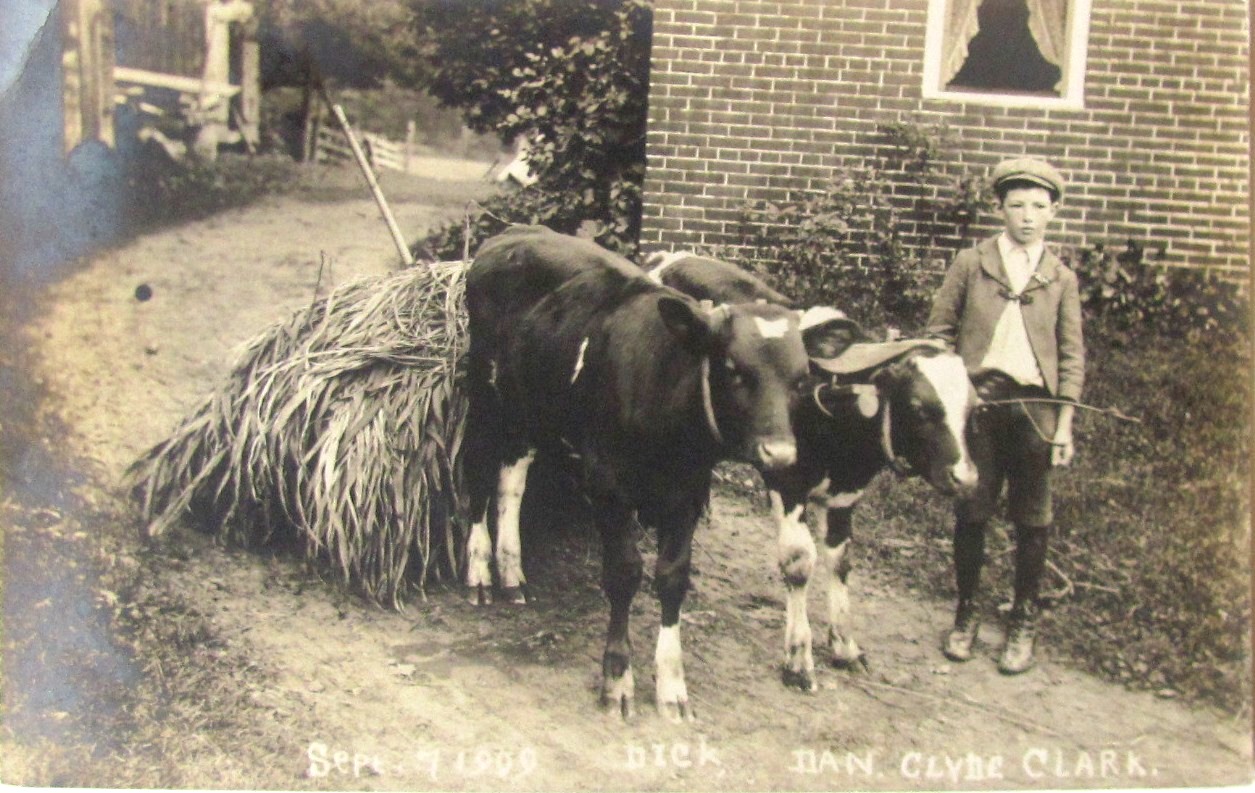The photo with this article is a 1909 postcard. Not only is it a great photograph, it reveals some interesting history.
The team
 The young oxen are in a small ox yoke, drawing a small wagon of some sort. You’ll notice the oxen are not matched when it comes to size. There is, written in white letters at the bottom, “Sept. 7 1909 Dick. Dan. Clyde Clark.” Charles Wellman was the photographer, and wrote this title in white ink directly on the glass negative. This way each postcard printed had this information.
The young oxen are in a small ox yoke, drawing a small wagon of some sort. You’ll notice the oxen are not matched when it comes to size. There is, written in white letters at the bottom, “Sept. 7 1909 Dick. Dan. Clyde Clark.” Charles Wellman was the photographer, and wrote this title in white ink directly on the glass negative. This way each postcard printed had this information.
Dick is the larger ox at left, Dan the smaller at right. A young Clyde Clark stands at right. I love the way he is dressed, including his cap. The photo was taken in 1909 Popple Dungeon at Frank Clark’s house. Today this is where Ruth Zezza lives.
If you look close, you can see in Clyde’s right hand a switch. The switch wasn’t used to whip the oxen. With repeated commands and touching the ox with the switch in different places, the ox learned what to do. This is what makes a teamster. Clyde’s father Frank was such a teamster.
In the old days, young boys and girls were taught by their parents a trade or skill. Parents prepared their kids for the world. In this photo, Clyde is 9 years old. Already he has a team of oxen earning money. Can you imagine a 9-year-old today driving a truck or making money?
Cattails
Clyde’s load is cattails. You can see the handle of a pitchfork sticking up. Cattails grow in wet, swampy areas. Clyde has gathered cattails to sell. There was undoubtedly a business in town that bought cattails, and shipped them via the railroad to points south.
As far back as the 1700s, cattails were used for rush seats in chairs. This continued into the early 1920s. Many will know of chairs with cane or splint seats. Clyde might have walked beside his oxen to Chester. On the return trip he would have ridden back. There may have been other uses for cattails that I am unaware of.
My father caned chair seats. He put rush seats in six Hitchcock chairs we had. By this time cattails were no longer used. Dad used rush made of twisted paper.
Clyde was a lister for the Town of Chester for years. He was a plumber by profession. His shop and home were on Elm Street on the town hall end.
In the photo I used last week was a load of firewood in front of the Donnis place. The driver was unidentified. Jon Clark has the same postcard. On Jon’s card the driver is identified as Frank Clark. That was a Wellman photo, as is the photo with this article. Wellman also photographed the annual Old Home Days in Popple Dungeon.
The message
The message on the address side: “Dear cousin Lora. I am sorry you did not come over this year. We are going to Aunt Mary’s for Christmas. Merry Christmas and a Happy New year. From Clyde Clark.” Jon Clark tells me Mary was Mary Clark Warner.
It was mailed from Chester on Dec. 23, 1909, to “Mrs. Lora Frail, Sunapee, N.H.” Jon did not know who Lora was.
In an old Carpenter Store News I read where Clyde was building his fifth house in Chester.
Instead of an old saying, I offer a short story. I was at a Dick Withington auction in Hillsboro, N.H., many years ago. He was selling an antique chair with a partial rush seat. By partial I mean it had a large hole in the center. Dick said, “This fine Chippendale chair has a rush seat. Sit in it and you’ll rush right through it.”